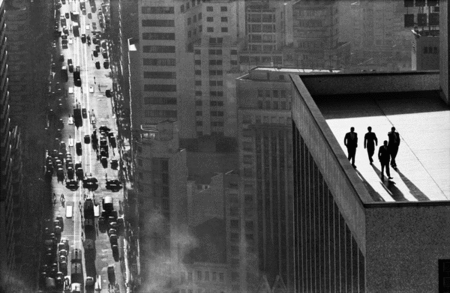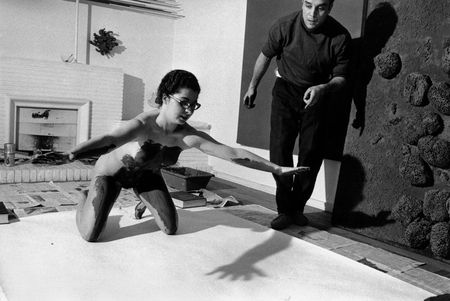"René Burri " @ KUNST HAUS WIEN
Havanna, Kuba. Industrieministerium. Ernesto Guevara (Che), während eines Exklusivinterviews in seinem Büro, 1963 © René Burri / Magnum Photos
VIENNA.- René Burri was born in Zurich in 1933. From 1959, as a member of Magnum Photos, he travelled to the scenes of innumerable world events. "The camera has always been a magic wand for me, giving me access to places where I could try new experiments," Burri has said.
He not only captured key moments in history, but also documented daily life in countries such as Brazil, China, Palestine, Vietnam and Germany. His portraits of such celebrated personalities as Pablo Picasso, Winston Churchill, Ernesto "Che" Guevara, Muhammad Anwar as-Sadat, Le Corbusier and Alberto Giacometti are counted among the iconic images of the 20th century. "Many of the images we remember from the second half of the 20th century are photographs taken by René Burri. Many people are familiar with these legendary photos, but few of them know much about the fascinating photographer who took them. With this retrospective, we hope to change this at least a little,” underlines Franz Patay, Director of KUNST HAUS WIEN.
Männer auf dem Dach, Sao Paulo, Brasilien, 1960 © René Burri / Magnum Photos
The two sides of René Burri
"As a photographer, René Burri is one of those who experienced the golden era of the great illustrated magazines before they capitulated to the competition of television, a medium that is faster, louder, and provides moving pictures. From Life to Look, from Stern to Paris-Match: there is scarcely an international magazine that Burri did not work for. And there is scarcely any event, any war in the second half of the 20th century, that is not documented in his overflowing archives. From the mid-1950s to the end of the century, Burri provided the world press with pictures. He was, and is, the personification of what is traditionally called a 'photo journalist'. What distinguishes Burri from most other photo journalists, however, is the fact that in addition to his contract work, he always did work of his own as well. There are, one might say, two Burris: the reliable provider of services, who is familiar with the needs of the press and knows the ins and outs of putting together a photo story, and the 'cameraman' driven by curiosity, a hunger for images, a desire for visual forms, who would never call himself an artist and yet is nothing less that one of the great aesthetes of 20th-century photography." -Hans-Michael Koetzle, curator of the exhibition
Amerikanische GIs in einem Club, Tae Song Dong, Korea 1961 © René Burri / Magnum Photos
Photographs for the press
The exhibition comprehensively shows both sides of the photographer René Burri, who always had a second Leica in his luggage for his personal photo projects. It begins by tracing the histories of some of his most famous press photographs, which went around the world. One of these is his world-famous photograph of Ernesto "Che" Guevara: In 1963, Burri accompanied the American star journalist Laura Bergquist to an exclusive interview with Guevara, who was at that time the minister of industry, in his office in Havana. For two and a half hours, Burri was given the opportunity to photograph Che in his office darkened by blinds. The picture that was to become an icon after Che Guevara’s death in 1967 played at first only a minor role in the press coverage.
Gasthaus Goldener Engel, Baumholder, 1959 © René Burri / Magnum Photos
The photographer as an author
A special section of the exhibition is devoted to René Burri’s particular style, his individual way of seeing things, the photographic subjects that interested him, the particularities of his visual language and the characteristics that define his photographic signature.
"As a photographer René Burri has many faces, but nevertheless his photographic signature is subtly distinctive. He absorbed central aspects of the 20th century: from the tenets of New Objectivity in the 1920s and the spirit of the Bauhaus, through the many Modernist artists who influenced him, to his involvement in the myth of the photographic cooperative Magnum, formed out of the politically alert and committed spirit of the Resistance and the imperative of highest photographic art. René Burri’s photographs are to be counted among the key images of the 20th century and as such have long since become part of the collective memory of humanity. Thanks to René Burri’s sensitivity and joie de vivre, these memories include many inspiring and encouraging moments," explains Andreas Hirsch, co-curator of the exhibition in Vienna.
Resa Cyrus Ali, Teheran, Iran, 1960 © René Burri / Magnum Photos
LIFE AND WORK
Formative years in the spirit of the Bauhaus and New Objectivity
René Burri took his first picture in 1946. He photographed Winston Churchill during the great statesman’s visit to Zurich, where he gave his famous speech ending with the words: "Let Europe arise!" At the age of thirteen, Burri was thus present at a historic moment and succeeded in photographing one of the most important personalities of the 20th century. Even though he did not become professionally involved in photography until years later, this experience appears to have been an indication of the road his life was to take.
Burri, who originally wanted to become a filmmaker, completed training in artistic photography, in the course of which he absorbed a touch of Bauhaus atmosphere. His basic studies with Johannes Itten were followed by studies with Hans Finsler, who taught in the spirit of New Objectivity. But it was not until Edward Steichen visited the school that Burri was inspired to leave puristic studies of objects behind him and begin photographing people in the streets.
Yves Klein in his studio, Paris, France, 1961 © René Burri / Magnum Photos
René Burri and Magnum
It was Burri’s compatriot, the Magnum photographer Werner Bischof, who showed some of René Burri’s early works to the founders of Magnum, but Bischof’s accidental death in the Andes prevented him from playing any further role as a mentor in Burri’s life. Burri’s reportage on Mimi Scheiblauer’s famous school for the deaf in Zurich, which appeared in Life magazine in 1955, was his admission ticket to the Magnum agency, of which he became a full member four years later. A series of photographs of Henri Cartier-Bresson looking out at 5th Avenue, taken by Burri immediately after the decision to admit him to Magnum, is included in the exhibition. A special documentary section is devoted to the theme of "Burri and Magnum"; a film by Reiner Holzemer tells the story of the photo agency, which was founded in 1947.
Life themes: Picasso, the Germans
The retrospective traces several of the life themes of the photographer René Burri, who devoted his attention to certain countries and persons over periods of many years. For instance, he did photographic portraits of numerous artists at frequent intervals – first and foremost Pablo Picasso. Long before meeting Picasso in person for the first time, Burri photographed the painter at the latter’s exhibition at the Palazzo Reale in Milan. Later, Burri was to photograph Picasso in bed, at meals and at bullfights.
In the late 1950s, Burri began working on photos series about life in Germany. His book "Die Deutschen" (The Germans) was published in 1962, but his interest in the subject continued. He also published a book about the culture of the gauchos in Argentina, and a documentary film about life in China in the 1960s. He collaborated closely with the Swiss cultural magazine DU for many years; this collaboration reflects many of his key themes.
Special highlight: "New York Blackout"
The exhibition offers another special highlight: Burri’s long-forgotten photo series taken during the New York blackout, which was rediscovered in 2003 and shown in public for the first time in 2009 at the Rencontres d'Arles. During the legendary "Northeast Blackout" in November 1965, René Burri spent half the night wandering through the streets of New York, which were only momentarily illuminated here and there by the odd match, flashlight or car headlight. He took 40 black-and-white photographs that night, all of which are being presented at this retrospective.

/https%3A%2F%2Fprofilepics.canalblog.com%2Fprofilepics%2F1%2F0%2F100183.jpg)
/https%3A%2F%2Fstorage.canalblog.com%2F03%2F02%2F119589%2F96711876_o.jpg)
/https%3A%2F%2Fstorage.canalblog.com%2F11%2F31%2F119589%2F94773502_o.jpg)
/https%3A%2F%2Fstorage.canalblog.com%2F20%2F83%2F119589%2F94772815_o.jpg)
/https%3A%2F%2Fstorage.canalblog.com%2F26%2F72%2F119589%2F75604929_o.jpg)
/https%3A%2F%2Fstorage.canalblog.com%2F59%2F60%2F119589%2F26458628_o.jpg)








/http%3A%2F%2Fstorage.canalblog.com%2F94%2F09%2F119589%2F128556743_o.jpg)
/http%3A%2F%2Fstorage.canalblog.com%2F69%2F75%2F119589%2F125961208_o.jpg)
/http%3A%2F%2Fstorage.canalblog.com%2F43%2F91%2F119589%2F121554867_o.jpg)
/http%3A%2F%2Fstorage.canalblog.com%2F00%2F33%2F119589%2F114771064_o.jpg)